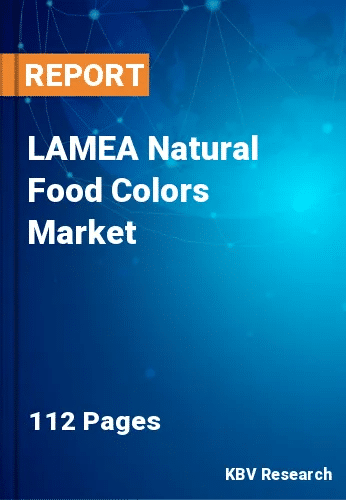
The Latin America, Middle East and Africa Natural Food Colors Market would witness market growth of 13.9% CAGR during the forecast period (2023-2030).
Natural food colors are used to flavor beverages, juices, baked goods, and confectionery items. The increasing need for natural food colors in the food and beverage sectors drives the market expansion. Additionally, the desire for natural food items with fewer or no artificial colors, preservatives, or additives has grown as a result of the expanding population.
Natural food colors are usually considered safe for consumption and are less likely to negatively impact health. They do not include dangerous chemicals and are sourced from plants, animal, or mineral sources. Adopting natural food colors correlates with an enormous rise in consumer awareness, the requirement to conform to strict labeling regulations and a growing perception that products with clearer labels are superior. Multicultural food producers are putting more of an emphasis on food standards, convenience, and a variety of cuisines, including packaged food which is predicted to result in market growth for the forecast period.
Smooth bread sales, both packaged and unpackaged, rose at a CAGR of 3.8%. Over the years 2022 to 2027, bread consumption is predicted to increase, with growth rates likely getting significantly across all categories. Producers of packaged bread will likely use more and more nutritious components in their products. Consumers concerned about the amount of protein, minerals, vitamins, and fiber in their diets are drawn to the grain, nut, and seed combinations in packaged baked products. Cake sales growth, whether packaged or unpackaged, remained constant from 2018 to 2022 but is predicted to increase from 2023 to 2027. From 2018 to 2022, the total growth of cake brands was constant at a CAGR of 1.0%. This rising sales of baked goods within the region is predicted to result in the growth of the market in LAMEA.
The Brazil market dominated the LAMEA Natural Food Colors Market by Country in 2022, and would continue to be a dominant market till 2030; thereby, achieving a market value of $53 million by 2030. The Argentina market is estimated to grow a CAGR of 14.5% during (2023 - 2030). Additionally, The UAE market would register a CAGR of 13.6% during (2023 - 2030).
Based on Solubility, the market is segmented into Water, and Dye. Based on Application, the market is segmented into Processed Food Products, and Beverages. Based on Source, the market is segmented into Plant, and Animal. Based on Form, the market is segmented into Powder and Liquid. Based on Color Type, the market is segmented into Carotenoids, Caramel, Anthocyanins, Carmine, Chlorophyll & Spirulina, Annatto, and Curcumin. Based on countries, the market is segmented into Brazil, Argentina, UAE, Saudi Arabia, South Africa, Nigeria, and Rest of LAMEA.
Free Valuable Insights: The Worldwide Natural Food Colors Market is Projected to reach USD 2.8 Billion by 2030, at a CAGR of 11%
The market research report covers the analysis of key stake holders of the market. Key companies profiled in the report include Archer Daniels Midland Company, Koninklijke DSM N.V., Döhler Gmbh, International Flavors & Fragrances Inc, GNT International B.V., Kalsec Inc., Givaudan SA, Sensient Technologies Corporation, Kanegrade Ltd. and Taiyo International (Taiyo Kagaku Corporation).
By Solubility
By Application
By Source
By Form
By Color Type
By Country
Our team of dedicated experts can provide you with attractive expansion opportunities for your business.
